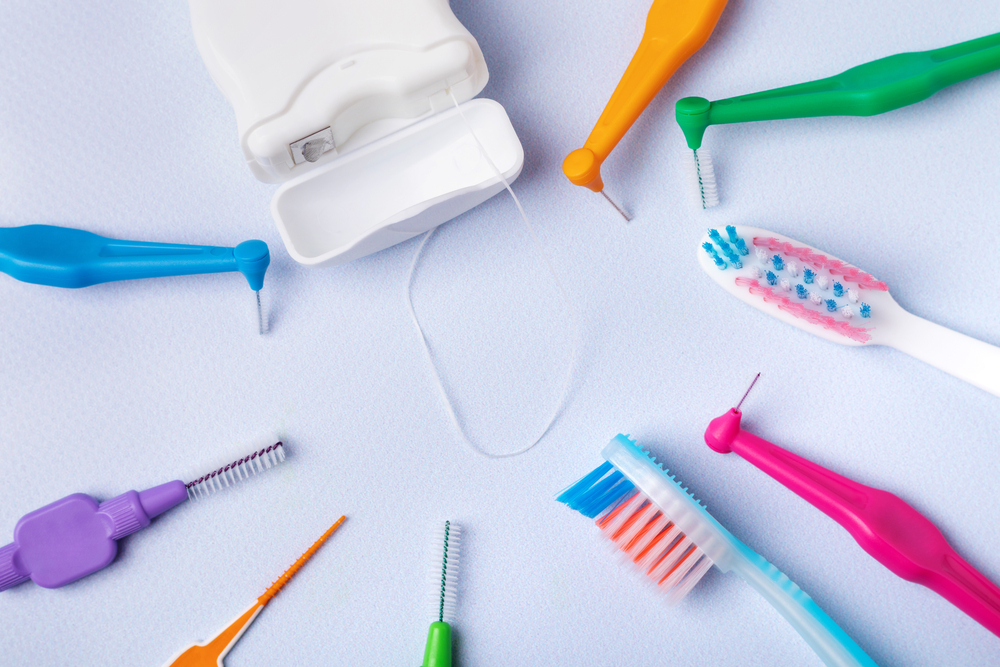From an early age, we learn that avoiding tooth decay or cavities is super important when it comes to our dental health. And, let’s be honest, we all know how great it is when the dentist announces at a checkup that you’re cavity-free!
Avoiding tooth decay and remaining cavity-free are especially important when you have braces. Dental health issues can interfere with your braces treatment — having cavities with braces can prolong or interrupt your treatment plan. And in some cases, your orthodontist might need to remove your braces if cavities under your braces need filling.
So it goes without saying that having cavity-free teeth is the best place to start your braces journey. But you might also be asking, can you get braces if you have cavities? Well, yes, but it’s not advised. We suggest visiting your dentist for a full dental exam and get any cavities filled before you get your braces. Then once you’re cavity-free and have started wearing braces, you’ll then want to ensure that your oral health stays in tip-top shape throughout treatment.
With that said, let’s talk about tooth decay and cavities so you can partner with your dental health professionals for the healthiest braces experience possible.
In this post, we’ll cover:
- What are tooth decay and cavities?
- Signs of tooth decay and cavities
- Treatment of dental issues when you wear braces
- How to prevent tooth decay with braces
- How Damon™ braces make brushing and flossing easier
What Are Tooth Decay and Cavities?
First things first, you might be wondering if there’s a difference between tooth decay and cavities. Simply put, yes! Tooth decay is the softening of your tooth enamel over time from acids. These acids are created in two ways: one, as a byproduct of bacteria breaking down sugars and plaque in your mouth after you’ve eaten, and, two, when foods containing carbohydrates — sugars — get trapped between teeth and are missed by poor brushing or flossing.
And cavities? Cavities happen when the acid has eaten away at the tooth enamel so much that holes begin to appear in your teeth. If you don’t catch cavities and treat them early, they can grow over time, causing pain, sensitivity, or difficulty eating. Sometimes they might even destroy an entire tooth. And in severe cases, your dentist might suggest tooth removal so you can avoid gum disease.
The likelihood of tooth decay and cavities increases with braces because brackets and wires add more nooks and crannies for tartar, plaque, and sugars to hide. And if your oral hygiene routines are, let’s say, less-than-stellar, it’s possible to miss those extra surfaces when you brush and floss, leading to tooth decay or cavities.
Signs of Tooth Decay or Cavities
Now that you know more about tooth decay and cavities, what do they look or feel like? You’ll be glad to know that both your dentist and orthodontist are trained to spot these dental issues, but it’s helpful to notice the following signs of tooth decay or cavities at home, too. If you do find issues, visit your dentist asap to get professionally examined, diagnosed, and treated.
Signs of tooth decay or cavities include:
- Black or brown stains, or white spots
- Pain when you bite chew
- Tooth sensitivity to hot, cold, or sweet foods
- Toothache or spontaneous pain that doesn’t have a physical reason
- Visible holes or pits in your tooth surfaces
How Dental Issues are Treated When You Wear Braces
Cavities before, during, and after braces look pretty much the same, and treatment is also the same whether you have braces or not. Your dental professionals will want to catch any cavities early and fill them so they don’t get worse. When you have cavities with braces, the location and size of your cavities dictates if your braces will be affected. The dentist might need to adjust your archwire or remove brackets to fix cavities that sit under your braces. Or, thankfully, sometimes cavities can be filled without disturbing your braces at all.
If your dentist decides that your braces need removal, your Henderson, NV orthodontist, Dr. Brady Okuda, will remove your braces at one appointment, then put them back on at another appointment after your dentist has filled your cavities. At Okuda Orthodontics, we understand you want your braces treatment to go as quickly as possible… you can’t wait to reveal a spectacular new smile! So we do our best to schedule these appointments close together, prolonging your braces journey as little as possible.
Now, we should mention that in some rare cases, your dentist might leave your cavities alone, opting not to fill them while you’re wearing braces. Maybe you have only a few weeks left until your braces come off for good and your cavities don’t look like they’ll worsen in that amount of time.
Once your braces have come off permanently, we suggest getting a dental check up soon after so the health of your teeth and gums can be assessed. After all, you want your newly-straightened smile to be both beautiful and healthy!
How to Prevent Tooth Decay with Braces
If possible, preventing tooth decay and cavities with braces is your overall goal. How to prevent tooth decay with braces? It comes down to three main habits: excellent oral care, choosing braces-friendly foods, and making it to all your dentist and orthodontist appointments. Let’s talk about these oral care tips in more detail:
1. Practicing Excellent Oral Care

Diligent, frequent brushing and flossing are your first defense against tooth decay and cavities. On top of brushing and flossing in the morning and at night, we recommend brushing your teeth after every meal to remove any bits of food stuck in your braces and avoid plaque build up.
Brushing With Braces
Always brush your teeth with a soft manual or electric toothbrush and fluoride toothpaste. Fluoride helps prevent cavities by slowing down tooth decay, speeding up remineralization, and forming enamel that is more resistant to acid. We should mention that if you’re thinking of brushing with whitening toothpaste while wearing braces, it’s better to wait until after your braces come off to whiten your teeth. Why? Whitening products don’t typically penetrate behind your braces brackets so you might end up with uneven whitening.
Flossing With Braces
Flossing is especially vital for keeping tooth decay at bay, cleaning between your teeth where brushing can’t reach. Floss before brushing as studies show that this order is more effective than the other way around. Floss at least once a day, as well as when needed to help remove plaque and food particles from between your teeth because a consistent, daily habit of flossing helps keep both teeth and gums healthy.
Some of our patients have found that maneuvering dental floss around archwires can be tricky at first. So what’s the best way to floss? With a few quick tips from Dr. Okuda and extra flossing tools at the ready, our patients find what works best for them and become pros at flossing with braces in no time.
After brushing and flossing, rinse with a fluoride mouthwash for an over-the-top clean. A good swish of mouthwash kills lingering bacteria and gives you fresh breath. In addition, some mouthwashes contain ingredients for braces wearers that soothe gum tissue and reduce white spots.
2. Choosing Braces-Friendly Foods
You might have heard that wearing braces can restrict your food choices. But in reality, you can eat pretty much anything when you have braces. Just choose foods that won’t damage or get stuck to your braces, or foods you can easily cut up into small, bite-sized pieces.
Of course, you want to maintain healthy eating habits and limit your sugar intake to avoid getting cavities with braces. Healthy, braces-friendly foods include foods like:
- Meats and seafood: soft-cooked chicken, meatballs, lunch meats, tuna, salmon
- Vegetables: mashed potatoes, steamed veggies, beans, soft veggies or sliced into small pieces
- Fruits: applesauce, bananas, fruit sliced into bite-sized pieces
- Dairy: soft cheese, pudding, milk-based (or dairy alternative) drinks
- Breads: soft tortillas, pancakes, muffins without nuts
- Grains: pasta, soft-cooked rice, quinoa, lentils
And foods to avoid with braces? It’s common knowledge that too much candy can result in tooth decay and cavities so it’s best to steer clear. And pass on food that is hard, sticky, crunchy, chewy. Food with these textures can get lodged in your braces or damage them. You should also stay away from foods you have to bite into, like corn on the cob, whole apples, carrots, or pizza.
3. Making it to All Your Dentist and Orthodontist Appointments
The third way to prevent tooth decay with braces is to make sure you attend all your dentist and orthodontist appointments. At your checkups, your dental professionals get the opportunity to spot signs of tooth decay or cavities, even under your braces. They can then prescribe treatment to fix any cavities or recommend how to continue maintaining healthy teeth and gums.
Dental checkups also ensure you get the deep clean that only a dental professional can provide with their expertise and special tools. Pair that with attending all your appointments with Okuda Orthodontics to keep your teeth-straightening on-track and healthy for your final smile reveal!
Easier Brushing and Flossing With Damon Braces
At Okuda Orthodontics, we offer a fourth way to prevent tooth decay and cavities with braces: the Damon™ braces system. When you think of braces, you most likely picture brackets, archwires, and elastic bands that work together to align your teeth and jaws. But as leading provider of Damon braces, we can level-up your braces experience. This innovative, self-ligating smile system eliminates the elastic bands and ties that can gather food debris and sticky sugars. And with more streamlined edges and a smaller size, the brackets on Damon braces make brushing and flossing more effective against plaque and tartar.
A Healthy Braces Journey with Okuda Orthodontics
Now that you’re up on what you need to know about braces and tooth decay, it’s a great time to get started on the stunning smile you’ve always wanted. Dr. Okuda and the team are ready to custom-design your unique smile, with the highest level of care and advanced orthodontic technology. And we’ll work with your dentist to help treat and prevent tooth decay, with as little interruption to your braces journey as possible. Contact us today for your free, in-person or virtual consultation with Okuda Orthodontics.


